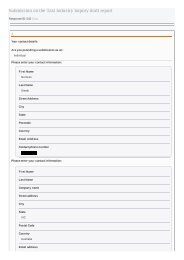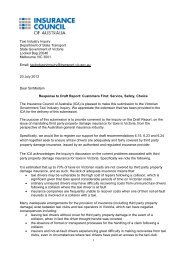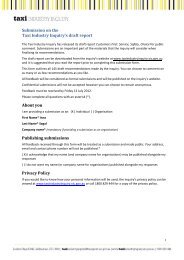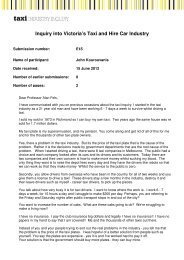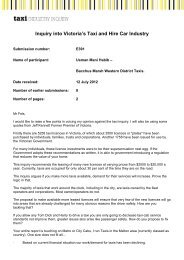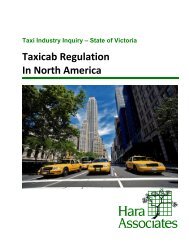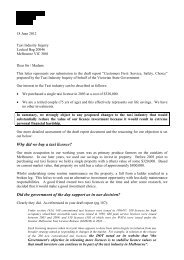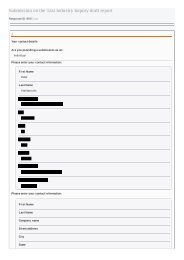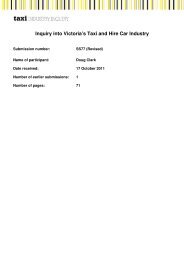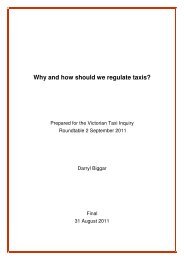Part D â Understanding and improving industry performance (PDF ...
Part D â Understanding and improving industry performance (PDF ...
Part D â Understanding and improving industry performance (PDF ...
You also want an ePaper? Increase the reach of your titles
YUMPU automatically turns print PDFs into web optimized ePapers that Google loves.
Case study<br />
Deregulation in Irel<strong>and</strong><br />
From 1978 to 1999, the Irish Government maintained quantitative restrictions on the number of taxi licences<br />
issued. Throughout this period, the number of licences issued failed to keep pace with the dem<strong>and</strong> for taxi<br />
services <strong>and</strong> there was widespread customer dissatisfaction with the poor availability of taxis in peak periods.<br />
Licence values in Dublin were in excess of IR£100,000 in 2000. Over the same period, there was strong growth in<br />
the number of hire car licences, which has no restriction on the number of licences issued.<br />
In 1999, amid calls for deregulation of the <strong>industry</strong>, the Irish Government decided to increase the number of<br />
taxi licences by issuing 2,600 additional licence to existing licensees <strong>and</strong> 500 licences to new entrants, with<br />
preference given to current taxi drivers.<br />
The Government’s actions were challenged in the courts because of the preferential treatment given to current<br />
licensees over new entrants. The Irish High Court found that the Government did not have the power to restrict<br />
the rights of entrants where the criteria were unrelated to qualitative st<strong>and</strong>ards. Following this decision, the<br />
Government effectively removed quantity restrictions overnight.<br />
The Government also determined that no compensation was to be paid to licence holders. This decision was<br />
also challenged in the courts, where the Irish High Court made it clear there was no legal obligation on the<br />
Government’s part to compensate operators for losses associated with changes of licence value.<br />
Further lobbying by former licence holders led the Government to establish a Taxi Hardship Panel to examine<br />
cases where extreme personal financial hardship was alleged as a result of these measures.<br />
The panel did not consider compensation for loss of licence value as such; rather, it considered payments<br />
‘solace’. Total payments of about €16.5 million were made, which represented less than five per cent of the total<br />
cost of paying full compensation.<br />
9.3.1. Entry controls<br />
The OECD has observed:<br />
Restrictions on entry to the taxi <strong>industry</strong> constitute<br />
an unjustified restriction on competition. Regulatory<br />
capture frequently means that these restrictions<br />
lead to large transfers from consumers to<br />
producers, economic distortions <strong>and</strong> associated<br />
deadweight losses. 4<br />
Liberalisation of the taxi <strong>industry</strong> is invariably associated<br />
with the liberalisation of licences. This is usually done<br />
through a government removing the quantity control on<br />
the upper limit of the number of licences permitted to<br />
operate in its jurisdiction. In most cases, this means that<br />
anyone who complies with some predetermined criteria<br />
for applying for a licence (such as a background criminal<br />
check, payment of an administration fee <strong>and</strong> so on) is<br />
granted the licence. Removal of entry controls typically<br />
occurs in conjunction with relaxing fare controls.<br />
One of the most discussed examples of deregulation of<br />
licences is Irel<strong>and</strong>, where deregulation was immediate –<br />
effectively occurring overnight (see case study). In 1999<br />
a High Court decided against the Irish Government’s<br />
approach to the release of new licences, citing that<br />
the government’s action gave preferential treatment<br />
to current license holders over new entrants. The<br />
Government’s response was to effectively allow the<br />
removal of quantity restrictions on licences.<br />
The number of taxi licences increased significantly <strong>and</strong><br />
waiting time for taxis reduced dramatically. At the time,<br />
however, there was no st<strong>and</strong>ardised fare system <strong>and</strong><br />
limited quality st<strong>and</strong>ard controls. The sudden liberalisation<br />
of licences led to calls from the <strong>industry</strong> for the return of<br />
controls <strong>and</strong> for more effective quality regulation.<br />
4 Ibid., p.7<br />
162




